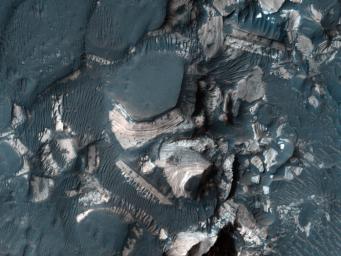
|
Flood-Emplaced Blocks in Holden Crater
- Click the image above for a larger view
- Full-Res JPEG (2560 x 1920) (886.2 kB)
- Full-Res TIFF (2560 x 1920) (14.8 MB)
Caption:

Figure 1
Click on the image for larger version
This image shows blocks of bright, layered rock embedded in darker material that are thought to have been deposited by a giant flood that occurred when Uzboi Valles breached the rim of Holden Crater (Grant et al ., 2008, Geology v. 36, p. 195-198).
The magnitude of this ancient flood is indicated by the large size of the blocks (up to 100 meters, or 328 feet, across) (Figure 1). The blocks do not appear to have been moved very far by the flood, as they are not rounded.
Holden Crater is one of the four potential landing sites for the Mars Science Laboratory rover, to be launched in November 2011. The bright layered rock in this image probably contain a record of a wetter, warmer period early in Martian history, and are therefore a prime target for exploration.
Background Info:
NASA's Jet Propulsion Laboratory, a division of the California Institute of Technology in Pasadena, manages the Mars Reconnaissance Orbiter for NASA's Science Mission Directorate, Washington. Lockheed Martin Space Systems, Denver, built the spacecraft. The High Resolution Imaging Science Experiment is operated by the University of Arizona, Tucson, and the instrument was built by Ball Aerospace & Technologies Corp., Boulder, Colo.
Cataloging Keywords:
| Name | Value | Additional Values |
|---|---|---|
| Target | Mars | |
| System | ||
| Target Type | Planet | |
| Mission | Mars Reconnaissance Orbiter (MRO) | Mars Science Laboratory (MSL) |
| Instrument Host | Mars Reconnaissance Orbiter | Curiosity Rover |
| Host Type | Orbiter | Rover |
| Instrument | High Resolution Imaging Science Experiment (HiRISE) | |
| Detector | ||
| Extra Keywords | Color, Crater | |
| Acquisition Date | ||
| Release Date | 2010-10-21 | |
| Date in Caption | ||
| Image Credit | NASA/JPL-Caltech/University of Arizona | |
| Source | photojournal.jpl.nasa.gov/catalog/PIA13533 | |
| Identifier | PIA13533 | |
